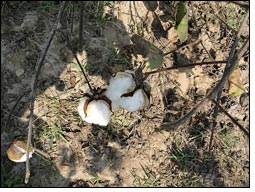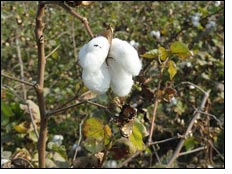|
Clear and bright weather has been reported from all cotton areas of Sindh and Punjab provinces during the last week which prompted matured cotton bolls to open.
One field report said that fields look white due to wide spread opening of bolls which accelerated picking process and also seed-cotton arrivals in to ginneries and market places (Mandi) especially in Punjab where cotton crop is reported to be in good to excellent form. The idea of a bumper cotton crop in Punjab is getting stronger and stronger day by day and most of the crop estimates now converge between 10.5 and 11.0 million bales.
Sindh province may yield 2.5 million bales estimating total national crop between 13.0 and 13.5 million 170-kg bales. The fortnightly cotton arrival figures of first fortnight of October month are due today and total seed-cotton arrivals by 15th October-11, may be estimated between 4.0 and 4.2 million bales.
The problem of cotton quality especially in Sindh province except Upper Sindh comprising of Sukkur and Ghotki districts may remain a permanent headache for the buyers during whole cotton season. Regarding cotton quality in Punjab, reports indicate that colour of cotton has not as yet improved to the level of 72-74 percent Rd which is generally required in export.
However, persistent sunshine in Punjab would improve the colour of cotton. Also Micronaire values are mostly reported high up to 5.2 which is undesirable. High Mic values may come down below 5.0 level hopefully in next fortnight. The domestic spinners appear worried about serious quality problem in Sindh cotton, which may force them to buy high quality cotton from other countries. Pakistan's domestic cotton consumption in this season is estimated around 13.5 million bales.
This season, on national level, we may be producing 30-40 percent cotton below average quality due to damage by heavy rains and flood specially in Sindh where 60-70 percent cotton may be below average quality. Local spinners appear prepared to face this quality problem which would ultimately affect quality of yarn, cloth and end-products accordingly. As a matter of fact, lint cotton having specification of Middling Grade, Staple length 1-3/32 to 1-1/18, Mic G-5 and 28-30 Gpt is in high demand in most of the cotton consuming countries in Asia. Pakistan's most popular Type 1503 with fibre specifications of staple 1-3/32 - 1-1/8, G-5 and GPT 28-30 is in high demand in Bangladesh which can comfortably spin 32-36 count yarn with good yarn strength. As such, Bangladeshi spinners appear reluctant in buying cotton from Pakistan fearing mixing of low quality cotton.
This season, India is producing a record high crop of 35.5 million 170-kg bales with 8 to 10 million bales surplus to their requirements and these surplus bales would mostly be exported to India's neighbouring countries viz: China, Bangladesh and Pakistan. Indian's most popular variety Shanke-6 has very good demand in these countries and is found to be competitive and viable in price and also logistically. Monetary strains and poor economic conditions are restricting cotton activities in Bangladesh.
In the local market, cotton prices remained depressed on increasing seed-cotton arrivals in ginneries. Rain-affected lint cotton of Lower Sindh was selling at Rs 5,500 while sound cotton of Upper Sindh and of good stations of Punjab at Rs 6,500-6.700 per maund ex-gin. Lint cotton from Mianwali station is fetching highest rate among others due to high quality.
Pakistan is reported to have sold some more than 166,000 bales of raw cotton in export mostly to China. Peak arrivals of seed cotton are expected in next month (November-11) and heavy cotton arrivals may squeeze cotton market in late November to December month when money market would become tight in view of closing of calendar year 2011 and increased loadshedding of power and gas specially in Punjab.
In January month, China may slacken its cotton purchases / imports after meeting its obligatory import quota of calendar year 2011 under WTO. The celebration of three week long holidays on Christmas and New year (20th December-11 to 10th January-12) occasions in most parts of the world especially West would make cotton market almost standstill.
The expected stimulation in Pakistan's political activities in December-11 and onward would slowdown economic and industrial activities. These factors may jointly exert pressure on cotton market and prices may come down around the level of Rs 5,000 for average quality cotton. The Government of Pakistan has plan to levy one percent turn-over tax on all textile sectors which may put the main foreign exchange contributing sector to new trouble. This one percent levy will be above one quarter percent Export Development Tax already levied on all textile sectors.
The recent increase of about 15 percent in electricity charges would increase production cost and make exports uncompetitive. On international front, sovereign credit crisis in Euro Zone and budgetary financial problems in USA and imbalance currency problems in China, and Japan may jeopardise economic activities in the world especially in West. The recent wide spread demonstrations and agitations of so called poor people against rich people in Europe and US are feared to engulf sores of countries the world over jeopardising the economic and industrial growth.
brecorder
|
|
World cotton consumption may be constrained on dull economic conditions
Updated: 2011-10-18 Source: brecorder

Recommended News
Photo Gallery
Most Popular



